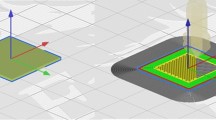Abstract
Gravure is the most popular process used to print on shrink films for larger volume runs and high-quality reproduction. Polyvinyl chloride (PVC) holds the major share in shrink application. However, print defects such as voids and dot skips are the major concern while printing on shrink PVC film. The presence of these defects degrades the print quality and causes print rejections. The electrostatic assist (ESA) in gravure is designed to eliminate dot skips; however, the effect of ESA parameters such as air gap and voltage on print defects needs to be explored in depth. Thus, this study aims to minimize print defects by optimization of gravure process parameters. The study investigates the effect of process parameters such as line screen, air gap (distance between charge bar and impression roller), viscosity, voltage and speed on voids and dot skips. A general full factorial was designed and statistical model was developed to determine the influence of each process parameter on defect minimization. The results showed the significance of all the process parameters in reduction of dot skips and void area. The improved ink transfer with ESA resulted in elimination of dot skips and minimization of void area by 96%.





Similar content being viewed by others
References
Steingraeber, JK, “Advancement in ESA in Rotogravure. Gravure Association of America magazine,” pp. 34–38, 2012. http://www.steingraeber-corp.com/GAA-Summer2012-p34-38(Antistatic).pdf. Accessed December 5, 2014
“Electrostatic Arrangement for Rotogravure and Flexographic Printing Unit”. US 6578478 B2, issued June 17, 2003
Martorana, E, Ziegler, H, Campo, FA, Juhe, HH, “Causes of Missing Dots in Rotogravure Printing.” Wochenblatt fur Papierfabrikation, 134 (11–12) 690–699 (2006)
Neff, JE, “Investigation of the Effects of Process Parameters on Performance of Gravure Printed ITO on Flexible Substrates,” Master’s thesis, Georgia Institute of Technology, Georgia, 2009
Webster, JR, “Thin Film Polymer Dielectrics for High-Voltage Applications Under Severe Environments,” Doctoral dissertation, Virginia Polytechnic Institute and State University, 1998
Deng, PJ, et al., “Influence of Screen Ruling and Engraving Needle Tip Angle on Ink Transfer for Gravure.” J. Adv. Mater. Res. Print. Packag. Study, 174 215–218 (2011)
Rajala, P, Milosavljevic, N, Kiiskinen, H, Hendrickson, M, The Effect of the Impingement Air Drying on Print Mottle and Other Coated Paper Properties.” Appl. Therm. Eng., 24 (17) 2527–2536 (2004)
Siler, S, Erin, T. “Update on Studies Regarding the Use of Electrostatic Assist with Water Based Inks.” http://www.hurletron.com/subhtml/pdf/wbinks.pdf. Accessed November 28, 2014
George, HF, Oppenheimer, RH, “Method and Apparatus for Transferring ink in Gravure Printing,” US Patent 4,697,514, 1987
Ramakrishnan, A, Kumar, S, “Electrohydrodynamic Deformation of Thin Liquid Films Near Surfaces with Topography.” Phys. Fluid, 26 122110 (2014)
Haney, MA, “The Effect of Electrostatic Assist on Gravure Printability.” Gravure Exchange Magazine. http://www.gravurexchange.com/gravurezine/0804-ezine/haney.htm. Accessed December 11, 2014
“Electrostatically Assisted Ink Transfer.” US Patent 3,489,082, issued January 13, 1970
Zaretsky, MC, Billow, SA, Whitney, RA, “Electrostatic Assist for Coating: The Effect of Surface Resistivity.” J. Electrostat., 61 (1) 31–42 (2004)
Rong, X, Pekarovicova, A, The Study of Dot Skips of Electromechanical and Laser Engraved Cylinders, Proceedings of 59th Annual Technical Association of Graphic Arts Technical Conference, Pittsburgh, PA, 2007
Acknowledgments
I would like to thank P. V. G’s College of Engineering and Technology, Pune, for providing the laboratory support for the research work. I would like to express my gratitude toward Enulec Electrostatics (Germany) for sponsoring the ESA system and Rossini (Italy) for furnishing ESA impression roller. I am thankful to Mr. Roy Rosenberger for his technical support on Verity Mottle software. I am grateful to Manish Packaging, Acuprint Systems Pvt. Ltd., and Flint Group India Pvt. Ltd. for sponsoring PVC substrate, cylinder and inks.
Author information
Authors and Affiliations
Corresponding author
Rights and permissions
About this article
Cite this article
Joshi, A.V. Effect of electrostatic assist and gravure process parameters on voids and dot skips reduction in shrink PVC film. J Coat Technol Res 13, 527–534 (2016). https://doi.org/10.1007/s11998-015-9774-0
Published:
Issue Date:
DOI: https://doi.org/10.1007/s11998-015-9774-0




